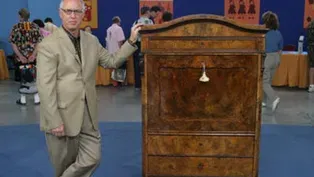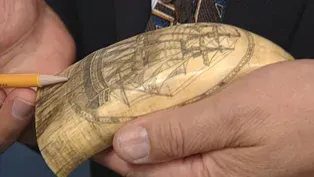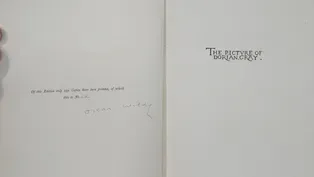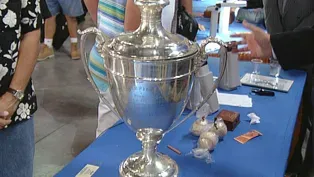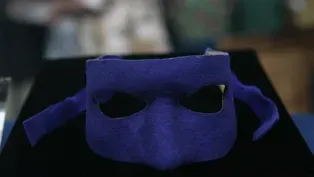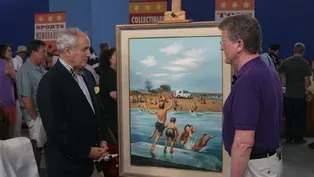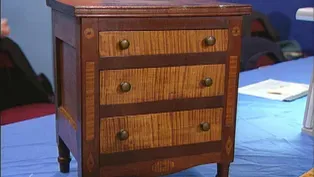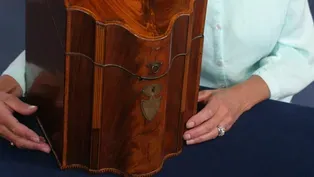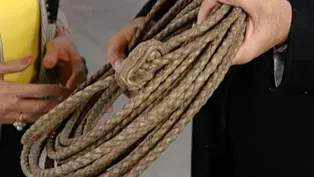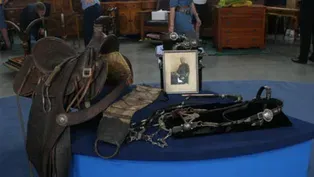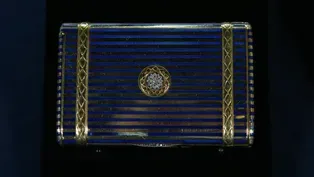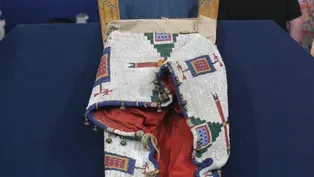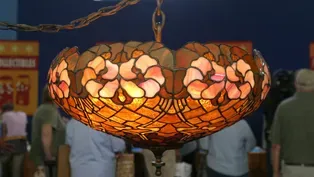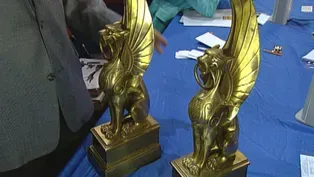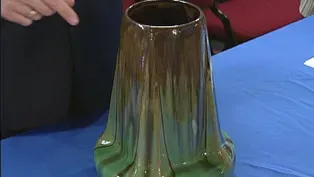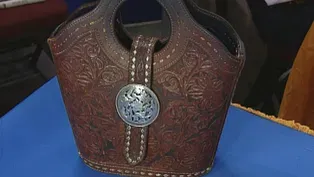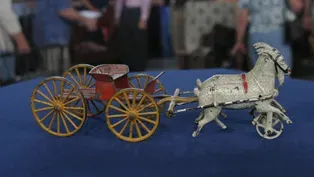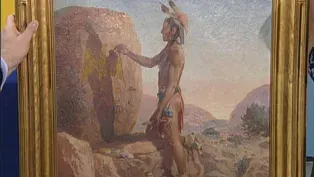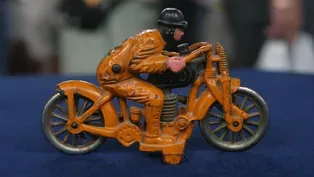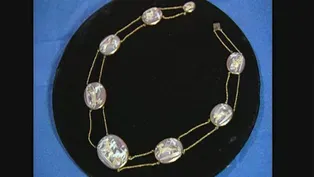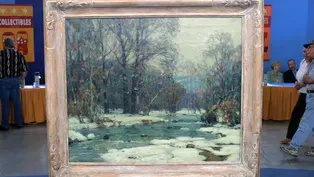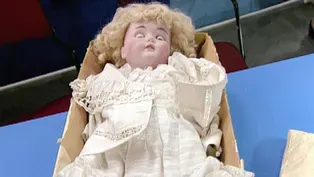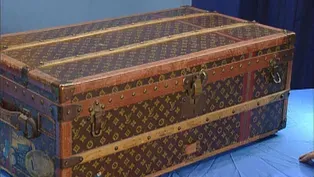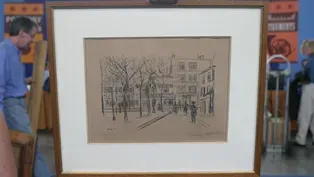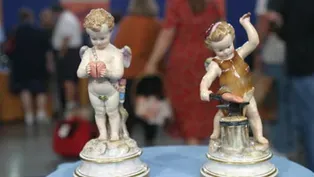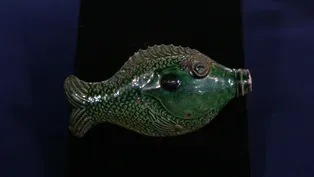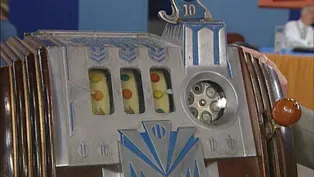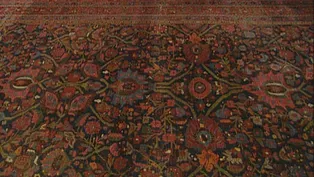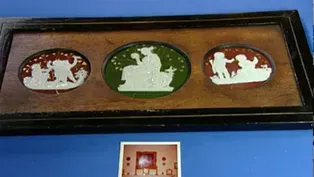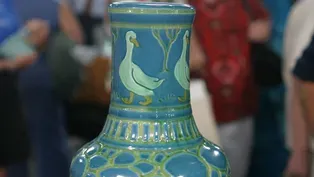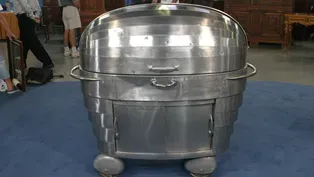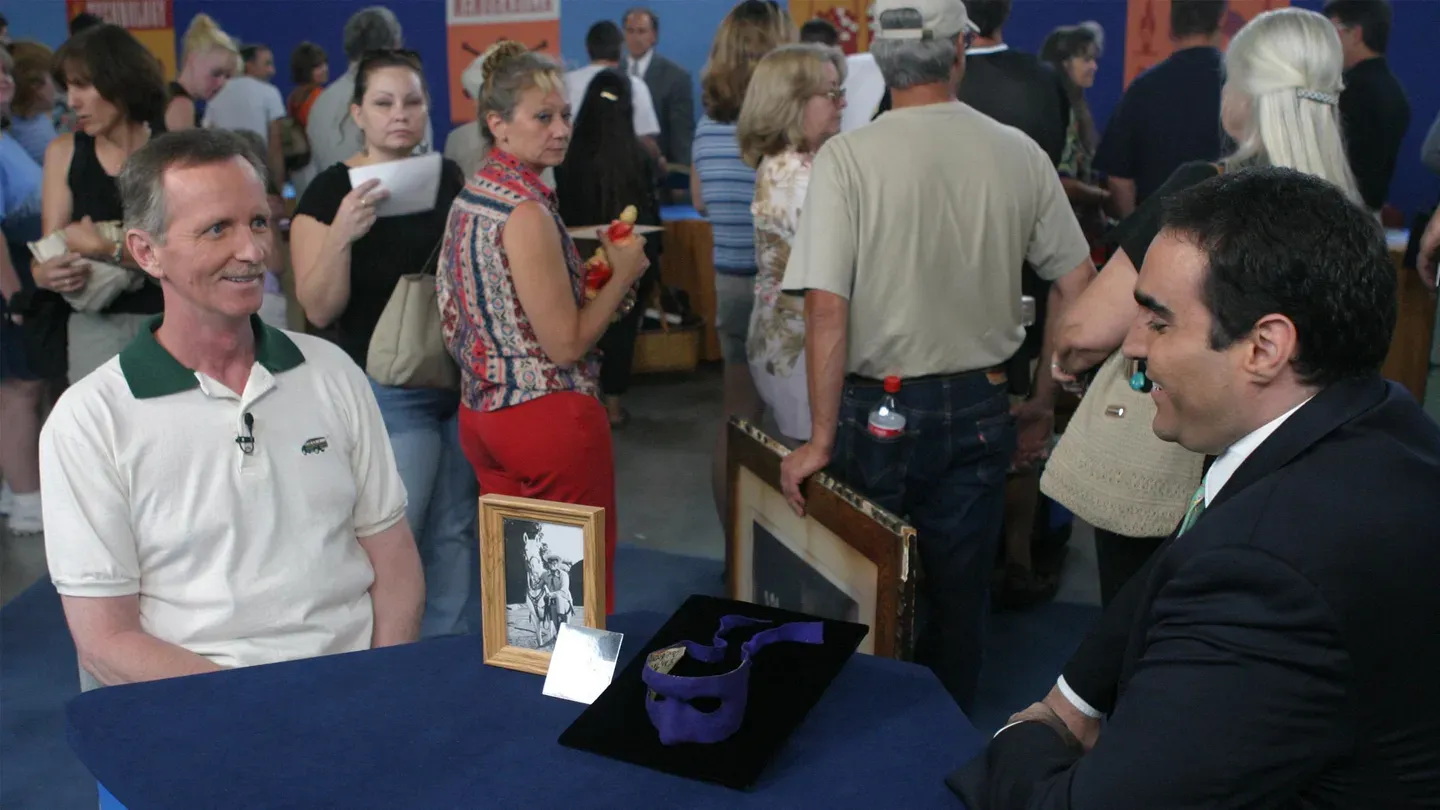

Vintage Reno
Season 23 Episode 17 | 52m 31sVideo has Closed Captions
"Go all in" on updated Reno appraisals from 2004. See what has since doubled in value!
Go all in on updated appraisals from the 2004 ANTIQUES ROADSHOW in Reno, including a 1951 inscribed Lone Ranger mask, a 1954 Stevan Dohanos cover illustration, and a Cartier cigarette case from around 1910. Which item has doubled in value to $80,000?
Problems with Closed Captions? Closed Captioning Feedback
Problems with Closed Captions? Closed Captioning Feedback
Funding for ANTIQUES ROADSHOW is provided by Ancestry and American Cruise Lines. Additional funding is provided by public television viewers.

Vintage Reno
Season 23 Episode 17 | 52m 31sVideo has Closed Captions
Go all in on updated appraisals from the 2004 ANTIQUES ROADSHOW in Reno, including a 1951 inscribed Lone Ranger mask, a 1954 Stevan Dohanos cover illustration, and a Cartier cigarette case from around 1910. Which item has doubled in value to $80,000?
Problems with Closed Captions? Closed Captioning Feedback
How to Watch Antiques Roadshow
Antiques Roadshow is available to stream on pbs.org and the free PBS App, available on iPhone, Apple TV, Android TV, Android smartphones, Amazon Fire TV, Amazon Fire Tablet, Roku, Samsung Smart TV, and Vizio.
Buy Now
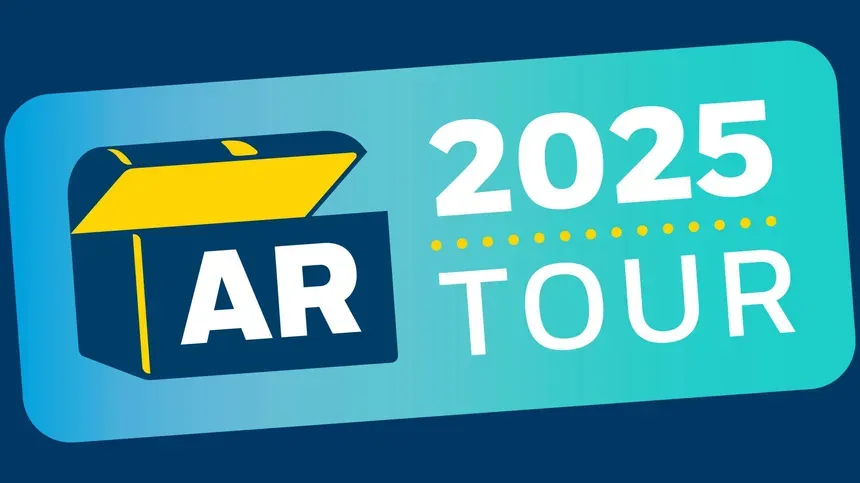
ANTIQUES ROADSHOW 2025 Tour!
Enter now for a chance to win free tickets to ANTIQUES ROADSHOW's 2025 Tour! Plus, see which cities we're headed to!Providing Support for PBS.org
Learn Moreabout PBS online sponsorshipIt made my day, believe me.
Made my year.
Wow!
Yeah.
Think I crawled all over this thing as a kid.
You gotta be kidding me!
APPRAISER: I'm not.
Ha!
What a joy!
(laughing): Oh, God!
♪ ♪ MARK WALBERG: In 2004, when "Antiques Roadshow" visited Reno, Nevada, the Biggest Little City in the world, we found a big crowd more than a little excited to show off their treasures.
15 years later, we're revisiting our stop in Reno to discover how the antiques, art, and collectibles markets have changed.
What went up, down, or stayed the same?
Find out in this fresh look at Reno.
MAN: What we're looking at is the mask that was used on the first episode of "The Lone Ranger."
A lot of people think of the Lone Ranger with the black mask.
The actual first masks were made of plaster of Paris over his face, and then they'd cover that with purple felt.
It gave a very good contrast with the costume that was used on the program.
And it was of course filmed in black and white and that's why they did that.
That's correct.
Now, you have a picture here and there's a little boy.
That's you.
That's correct.
And that's Clayton Moore.
Yes, it is.
The Lone Ranger.
My father was very active in the film industry.
He met a lot of famous people.
And they had a next-door neighbor who introduced my father to Clayton Moore, and they became very close friends.
Mm-hmm.
And as a child you used to go over to Clayton's house?
Yes, we'd have barbecues over there and go swimming.
As a matter of fact, Uncle Clayton taught me how to swim.
Mm-hmm.
And he'd come over to dinner one night, and he brought this mask with him.
My dad asked him if he wouldn't autograph it, and he did just that.
He signed it, "Clayton Moore, The Lone Ranger," and he dated it 1951.
And then he put on the other side, "To my pal," and then he put for my mother, "And Layla too," (laughs) So this is the actual mask that the Lone Ranger wore in the first television series.
That's correct.
The episode was "Pete and Pedro."
He eventually changed it, correct?
That's correct.
He did not like this mask because it covered too much of his face.
He designed the black mask as it's known today.
This is an iconic item.
Judy Garland's ruby red slippers.
Right, right.
Clayton Moore's mask as the Lone Ranger.
It's one of these pieces that just kind of takes your breath away when you see it.
I mean, everyone who's looked at this today has been like, "Whoa, hey!"
You know, and everyone's a little curious why is it purple?
But it makes perfect sense.
I think that this is worth at least $25,000.
Oh, my gosh!
At an auction, who knows what could happen, sky's the limit.
The fact that it's signed by Clayton Moore to your father, the family connection, it's remarkable.
This stuff comes into the show and it blows my mind, and... here it is, Lone Ranger's mask, you know, who would have thought.
Yeah, exactly.
It's definitely worth its weight in silver, isn't it?
(laughing): Absolutely.
That's great.
WOMAN: Well I got this Oscar Wilde about 25 years ago.
I bought it at a used bookstore on Wells Avenue.
APPRAISER: And what did you pay for it?
I paid $25.
Well, what you have is a copy of "The Picture of Dorian Gray."
Now, Oscar Wilde's the great Irish writer known primarily as a playwright, but also known through this very important book.
Now, with modern literature, especially in this period, books often came out in different editions.
They came out in a trade edition, then they would come out in a limited edition.
Now, the trade edition of this book, which came out in 1891, same date as this book, it looks much the same as this copy, and it brings roughly $400 to $600 at auction.
Now, your copy is one of the very special limited copies.
Here's the limitation page, which states that there were 250 copies of this edition published.
This copy's number 14, and it is signed by Oscar Wilde.
Now, the fact that it is the limited edition makes it a very special issue of the book.
I'd like to just point out some of the condition issues.
If we look at the back strip of your book you'll see at the bottom you've got this chip here and a few tears at the top.
Mm-hmm.
And for this book that's actually quite normal because the spine was made out of a very thin paper, very fragile.
It's actually an acceptable amount of defect because it's often found with the spine lacking.
Now, if you were to think about today's market, where Oscar Wilde has become very popular and is widely collected and sold at auction, do you have any guesses to what it might bring?
I'd say maybe $100, maybe $150 at the most.
Your $25 investment has gone up quite considerably in this market.
Recently copies of this book, the one of 250, have sold at auction for $8,000 to $12,000.
You gotta be kidding me!
I'm not.
Ha!
That is...
It's an amazing return on your investment.
...unbelievable!
You have an incredible eye for rare books.
Thanks for bringing it in.
You betcha!
This is-- what a joy!
(laughing): Oh, God!
And an old lady of 76 years old has got... Oh, my God!
It's a sperm whale tooth, probably done aboard ship either from New Bedford or from probably Nantucket.
We have a frigate here, we have an American flag.
If we look down on the scrimshawing on the bottom, you can see that the age split and the shrinkage of this tooth does not match up to the lines.
So that means to indicate that there's definite good age on this tooth here.
You know who they're made by.
Wedgwood.
Yes.
Now, most people think of Wedgwood, they think of Jasper, which is a hard porcelain-- blue and white, or green and white.
These are actually what they call pâte-sur-pâte.
And pâte-sur-pâte means "paste on paste."
APPRAISER: This started out as one big cowhide, possibly four, and they started out on the edge, and they cut a little strip Oh, they did?
all the way around and around and around Yeah.
to the center and then they braid it together to make a rope.
So it's a real labor-intensive process.
The reason it lasts so well, these are rubbed with tallow.
APPRAISER: You brought a slot machine to the show today.
MAN: Yes, I did.
How'd you acquire it?
I was purchasing a new house, it was in the house, Uh-huh.
and I negotiated to have it stay with the house when I purchased it.
It's a Pace slot machine, it's called the Royal Comet, and it was made about 1937.
I know that it came in two models: the nickel and the dime.
All cabinet-style machines are rare.
This one's extremely rare, at least I've never seen it before.
Right.
The nice thing about it, it's all original finish, you haven't restored it, this is replaced, probably, here, but the really great thing is it's unrestored.
This is the payout drawer here, which I think is kind of unique, that it's hidden like that.
The value I'd place on it is $3,500.
Okay.
WOMAN: I found it in the shed in a box.
It had this little note tied to it, which was from this woman who was my husband's great-great-great-grandmother.
In the note she's giving it to her grandson.
She says she's had it 86 years, I think, at that point, and she gave it to him in 1889.
I took it to an antique shop locally one time, and the guy said, "Hey, you know, "it's cute, but it's probably only good for family history, so keep it and enjoy it."
This actually is a very early piece of American ceramics.
Really?
It's a Moravian Pottery piece, made by the Moravian potters of Old Salem, North Carolina.
Wow.
And the pottery there in Old Salem was built around 1770.
And the Moravians came there and they were making redware pottery not far away in South Carolina.
John Bartlam founded the first English-type pottery in the United States.
His foreman was William Ellis, and after Bartlam failed, Ellis went to the Moravian potters and taught them how to make pottery in the English manner instead of the German manner and do press molding.
Now this is a press-molded little flask in the form of a fish.
And he also taught them to make bottles in the form of squirrels, bears, and they are very, very highly collected these days.
And this, though, is about the smallest I've ever seen.
Really?
I mean, this is for someone who couldn't take much whiskey.
(both laughing) Yeah.
It has a green glaze, which these animals mostly either had green or brown glazes that they made.
I would say that this fish dates between 1805 and 1815.
Wow.
It's possibly the finest piece of American pottery I've ever seen on the "Roadshow."
I know you noticed it's got a little crack under the lip.
Does that... Well, a piece is missing.
Yeah.
But a piece of this importance, it doesn't make much difference.
It can be restored for a couple hundred dollars, something like that.
As to a value, get ready.
Oh no.
$27,000 to $30,000.
Oh, my gosh.
(laughing): Oh gee.
How does that strike you?
(crying): Pretty amazing.
(laughs) Wow.
It made my day, believe me.
Made my year.
(both laughing) Thank you.
WOMAN: This box was a piece that I inherited.
And my grandparents were originally from Boston.
It's from a pair.
I remember as a child it was on a sideboard with family silver in the box.
You mentioned sideboard, and what's important to understand about boxes that keep silver flatware or cutlery is that sideboards were made for dining rooms.
And dining rooms didn't really exist as a separate room in which you would have your meals until the end of the 18th century and the beginning of the 19th century.
And so sideboards, federal sideboards in America, had these boxes that were made for them that sat on top of them in which to hold your cutlery.
And this box has a beautiful arrangement of holes your knives, and forks, and spoons would slide into, and then they would have been locked up-- this beautiful silver-mounted lock here-- to keep the silver flatware safe when it wasn't being used.
What's so exciting about your box here is that you said it's one of a pair.
These are often split up over the years, so it's rare to have a pair of boxes.
And then this one is even rarer because it's American.
The secondary wood is North American white pine, and if you look along the base, you see the sawtooth inlay decoration, which is very typical of Boston, which is where you said your family came from.
This is mahogany, and you see these beautiful inlaid pilasters on the front of the piece.
Would the sideboard been a companion with the knife boxes?
Very probably.
And in very rare instances you see that the decoration matches the sideboard.
Does the family still have the sideboard?
Yes.
I have it.
Well, this single knife box would be worth $5,000 to $8,000.
But a pair... Wow... ...would bring $20,000 to $30,000.
(laughing) Where's a Kleenex?
Oh, my God!
Isn't it amazing?
Geez.
Wow.
So I'm glad your family took care of it.
That's so... that's incredible.
APPRAISER: Have you had this in your family long?
WOMAN: I think since the late 1800s, early 1900s.
My great-uncle was in the army and traveled around a lot.
You know where he got it?
I think off a reservation, because it's... it looks like it's been used.
Mm-hmm.
But I don't know.
It was made by the Cheyenne, probably the southern Cheyenne, and that probably would have been when they were in Oklahoma.
The Cheyenne made beautiful cradles, they're considered absolutely classic, fully-beaded cradles.
They were the ones that used the cradle boards, as opposed to the Lakota, who didn't use boards.
They would have made a soft cradle.
I magnified the inside, and it's on buffalo hide and then mounted on canvas, which is very typical of the early reservation period.
This would have been made probably in about 1880 to '85.
The design's a very classic Cheyenne.
They have a box-and-border design here.
These are stylized thunderbirds, which are very desirable, on each side of the box-and-border.
I particularly like the little hawk bells hanging around the opening.
Of course, the only problem with the cradle is its shape-- it's kind of misshapen.
Because the leather on this cradle is not stiff, and the market knows that it can be reshaped, so the value is $40,000 to $60,000, as is.
If the hide was stiff, it would be a different matter.
Okay.
Well, it was given to me when I first started going with my husband, probably 50 years ago.
His great-aunt was related to the Bowers from Bowers Mansion, which was the discoverer of silver in the silver mines of Virginia City.
So the piece was originally from their mansion in Virginia City, mid-19th century.
The mansion is in between Reno and Carson City.
It's by the artist Victor Dubreuil.
Victor Dubreuil was an interesting artist.
He was American, 19th century, and painted in the trompe l'oeil painting style.
And what that means is "fool the eye."
And he's done a pretty good job with this treasury note from roughly 1891.
We can see shadows, we can see creases.
He's really done a remarkable job in capturing a silver dollar bill that has been in somebody's pocket or someone's drawer.
It's really a terrific example of the trompe l'oeil style of painting.
There isn't a great deal known about the artist.
What we do know about him is that he apparently was obsessed with money.
He would paint barrels of money.
He would paint stacks of money.
He would paint single bills.
He would paint a couple bills.
He really liked his money.
But someone once wrote about him that perhaps the reason he was so obsessed was because he had so little.
The condition of the painting looks fine, but restored.
Now, did you have the painting restored?
Unfortunately, I had it cleaned, and it had a small tear on it, and I thought it might be better than just stretched on the boards, to put it on a back.
So they backed it.
As young as I was then, I put a garish, today's frame on it.
So I hope I haven't ruined it.
No, the frame is a modern frame.
The condition of the painting is in good restored condition.
It's unfortunate that it couldn't have been left on the original stretchers, but it's in fine condition.
There is, of course, a hierarchy in his value.
The barrels of money sell for barrels of money.
I think one sold for over $250,000.
But this single, wonderful little bill, with Martha Washington looking out at us, is worth, for insurance purposes, about $15,000.
Oh.
So little did we know about things that we have with us.
And it's a great one to have.
Thank you very much.
It's nice to learn about it.
I remember the story that my parents spent maybe about two months' wages on them, and it was a big decision for them to make, to purchase them.
I feel the andirons were made around 1920.
They're not signed.
♪ ♪ Back in the early '70s we lived with a next-door neighbor who was a saddlemaker.
And I had asked him if he would make a purse for me.
I think I got it in about '74 or '75.
The great part about it is, is... Ginger, your name in sterling silver.
♪ ♪ This is a map of the Comstock Mines, which were located very close to here in Reno.
This was a map that was done for people to get information on who had the mines, where the mines were located in Comstock.
MAN: It was my grandfather's, who was a antique dealer in Doylestown, Pennsylvania.
I don't know if he made it, and it went to my father when he married my mother.
And then it came down to me.
He definitely didn't make it.
Okay.
This is a piece that would date to the 1820s, or 1830s maybe.
They're a little bit hard to pin down specifically because they're more of a rural interpretation.
This isn't made, necessarily, in an urban center.
But the main reason this is so exciting is that in the collecting world, and to the people out there who are seeking these things, small is big.
Perfect little gems like this are what really send the collectors to the moon.
If you're collecting chests of drawers, you can only fit so many into your room, or in the house.
But I've seen collectors who will take these little things and make a whole wall of them.
Tiger maple, you find used in Pennsylvania, but it's a little bit more common in New England.
And I think, actually, despite the fact of the Doylestown history, I think this might be more of a New England piece.
Oh.
The secondary woods are white pine and what looks like basswood.
You find that in Vermont and sort of northern New England.
The inlay that you see on here, you find those motifs, the little diamond motif, you find it in New York and Pennsylvania.
But what this is really about is a perfect little gem of an object.
You said that a lot of dealers had been knocking on your door, trying...
Right.
That's always a good sign when they keep calling.
Yeah, they would offer something, and then call me back, say they found somebody else who might offer me more.
And I would just say no, and that's why I brought it here.
Okay; did they make you any specific offers?
I, I had $1,500, in that area.
Maybe $2,000 if they could find somebody.
Okay; I think you're smart to have held off a little bit.
I think, at auction, I could see this estimated at $6,000 to $8,000.
Oh, my God, wow.
And I wouldn't be surprised if it, if it even did a bit more.
Great news, that's a shocker.
BOY: This was my great-grandpa's when he was a kid.
Then when he got too old, he gave it to my grandma, and it's just been sitting on a shelf.
APPRAISER: And now she is going to give it to you?
Yeah.
Well, that's great.
Family, family heirloom.
What do you think it is?
A Harley-Davidson.
And how do you know it's a Harley-Davidson?
Because of the "H.D."
H.D., right there.
Yeah.
Harley-Davidson started in the early 20th century, and probably the most famous American motorcycle company.
It's called a hill climber.
It has a racing number.
He has a number two on here.
In the real sport of hill climbing, Harley-Davidsons and other motorcycles in the time, in the '20s and '30s, would go to these giant hills, and they would race to see who could get up the hill the fastest.
Now, it was made in the early '30s, in Lancaster, Pennsylvania.
It was made by a company called Hubley and they came in multiple colors, and orange is a very nice color.
And they made a lot of Harley-Davidsons, they made Elgin street sweepers, and all these tie-ins with real companies.
You always had it on a shelf, correct?
Actually, my grandma always had it on a shelf, and I was only allowed to hold it, but not play with it.
Yeah.
Do you have any guesses on value, or any of that kind of thing?
I'm giving a guess about $1,000?
About $1,000?
Now, what makes you think it was worth $1,000?
Because... because at the time, Harleys were so popular, and how it was to promote...
Right.
...and all that other stuff.
Well, I think it's a little higher than that, easily about $2,000 to $2,500.
And that's a, you know, a fair-market value, an auction estimate.
Wow.
Yeah.
So what are you going to do with it?
Play with it carefully.
Like, just go around on the carpet in circles.
Yeah.
MAN: Well, I know it's a Visalia saddle.
It was given to my great-grandfather by a brigadier general, John Koster, who was in the California State Militia.
My great-grandfather worked for General Koster at the California Barrel Company.
The general kind of took him under his wing and was somewhat of a mentor and gave him this saddle as a gift, when he was a young man.
This is General Koster in the photograph, in uniform?
Correct.
What you have here is probably one of the finest California riding outfits I've ever seen.
And it's made by Visalia, the most important saddlemaker in California, from that time period.
Probably dates to between the mid-1890s and 1900.
It just doesn't get much better than this.
I was very surprised to see you come in with it.
The bridle was not made by Visalia.
It was probably contracted out.
Hm.
As were the spurs.
There is a chance that the silverwork was done by Schaezlein in San Francisco.
But they would have to look at it and compare it to work that they had done and their dies to figure out if that's who did it.
Every piece is marked with a "K," for Koster, including the bit, the bridle, everything.
So it's a custom-made outfit from start to finish.
The cinch is a horsehair cinch, and it says, "Walker Visalia, California."
And everything's marked with the leather and the saddle.
And there's a different Walker imprint on the back of the saddle, and it's possible that would even narrow down the date closer.
The bit and the spurs were obviously the same maker.
Filigree cut on the side of the bit, which is very unusual.
Filigree cut on the side of the spurs, which is very unusual.
They were difficult to make.
The head stall is a classic California rig.
It's what's called closed-reins with a romal.
I've never seen one that's totally silver-mounted, which this is.
Mm-hmm.
And I guess you want to know how much it's worth?
The butterflies in my stomach are killing me right now, about its value, so... (laughs) We'll start with the spurs.
Okay.
Not knowing who made them, but knowing the documentation, it's $4,000 to $6,000.
Wow.
Easy.
Probably more.
Mmm.
The head stall, $3,000 to $5,000.
All of this is conservative.
This isn't high retail prices.
Mm-hmm.
The saddle, I'd say $8,000 to $10,000.
Wow.
And then you have the martingale, that went around the horse's neck.
It's probably a replacement.
It's $1,000, easily.
The rest of it is totally original.
So, I mean, the whole rig, $16,000 on the low end, $22,000 on the high end.
Mmm.
If we went to the books, went to some other people that specialize in California spur-making and bits, we could probably discover who made these spurs and this bit, start adding percentages to it-- ten, 20%.
So then we're getting up towards $25,000 for the whole outfit.
Wow.
To think I crawled all over this thing as a kid.
Yeah, it's been a great heirloom to have in the family.
It's wonderful.
I mean, it is the top of California saddle-making.
MAN: This is a stainless steel, prime-rib table-service cart.
And I purchased it about a couple years ago from the John Ascuaga's warehouse auction, Yeah.
which was mainly just surplus equipment.
John Ascuaga came to town in the early '50s and started with a restaurant with maybe a couple slot machines, I'm not sure.
He's the last of the original '50s-era casino operators that still is alive and operating his own casino.
Ah.
And he was at the auction.
He gave me a little history on this cart.
It has sterno heat in it, and it keeps your prime rib sizzling, and it served the prime ribs at the table.
And this is a cart that he originally used when he first opened up in Sparks in the early '50s.
Well, it's interesting, because it probably wasn't new when he bought it.
It's actually a piece that's from the 1930s, and it exhibits this great, 1930s streamlined design.
It actually looks like a zeppelin, the way it has these lines on it, and the way it comes together at the front.
And I think what really gives it that modern look are these wheel covers on the bottom.
The wheels.
We really don't know where these were made.
There's some debate about whether or not they were made in Europe or whether they were made in the United States, but they do show up.
They show up in different materials, they show up in aluminum, sometimes they're painted, sometimes they have vinyl on them.
This seems to be a really unusual one in the metal, and the form is just wonderful.
And there's a real great craze now for the streamlined, modern design.
What did you pay for it, a few years back?
Around $600.
Now a piece like this at auction would probably bring between $6,000 and $8,000.
The value I'm putting on is based on it as just a wonderful, wonderful example of '30s design.
It drew a lot of attention on the way in here.
It certainly did.
WOMAN: My mom owned a little restaurant, it was a trolley car.
Our town is pretty small.
And a man came by one day, and didn't have any money for food, and he asked my mom if he could have breakfast for this piece.
And my mom says, "How about three breakfasts?"
So he came three times in a row, and this is how I received it.
You grew up in this restaurant so you remember this man?
Yeah, I was about probably ten to 12.
Where did you keep this?
I kept it underneath my bed in a box.
Probably nine, ten years in that box.
Never even taken it out to look at it.
You know what it is, it's a cigarette box.
Right.
It opens up, and then the cigarettes went in here.
And there was another hinged part off on the side, and you could see the striker.
And that held the matches.
They used strike-anywhere matches.
And it's a gold box.
Oh, my goodness.
Now, you know it's pretty heavy.
We tried to weigh it, and I put it on the jeweler's scale, and it went off the mark, because that only goes up to two-and-a-half ounces.
We weighed it on the silver scale, and figured out that, just to melt it, it's 18-karat gold, would be about $2,000 in scrap gold.
Oh, my goodness.
And the first thing that struck me as soon as you put it down on the table was the wonderful design.
It looks sort of like the Fabergé-style boxes from the turn of the century, the alternating stripes of blue enamel, and then this stripe here with a wreath-like design.
And then there's the center plaque.
That's platinum and diamonds.
Oh, that is diamonds?
And filigree.
And those are real diamonds.
They're rose-cut diamonds, they're not quite as sparkly.
They wanted a lesser sparkle, more subtle.
And there's more diamonds here, on the lip of the front of the box, where you would open it.
And when I opened it, I noticed there was a little dimple on the lip of the box, which is a typical place for a French hallmark, and we found it there.
And the French made the most beautiful boxes.
Oh, my goodness.
And now, we looked at the lip along the front of the box here, and there's where we discovered the signature of Cartier, Paris.
Oh, my goodness!
So the news just keeps getting better.
But we have some issues with condition.
Okay.
There's some chips in the enamel on the top section here.
There's some wear spots near the thumb rest, just from it being opened and closed so many times.
Mm-hmm.
I believe that if this was to be sold in as-is condition, it would achieve a price today of about $7,500... Oh, my goodness!
As it is.
Mm-hmm.
It's possible to restore this box, and a master restorer could put back the enamel that's missing from it in the damaged sections.
It might cost a couple of thousand dollars.
In restored condition, I think the collectors would be eager to buy it at a price of about $15,000.
(laughing): Oh, my goodness!
I never...
I would have just thought, $50, $75 is what I really thought.
Oh, my goodness.
I'm shocked.
Never thought of that.
So, you know, it pays to do good deeds for hungry men, I guess.
I guess, yeah.
Yeah, now I have to go home and see what else she has in that box.
I think that's worth checking out.
Yeah.
Oh, my goodness.
And you can't help but wonder who this man was.
when you had a gold cigarette box from Cartier's at the turn of the century, you were somebody.
Oh, my goodness.
My father worked for William Randolph Hearst during the Depression.
Yeah.
And I believe that it probably originated there.
Ah, so it had an exciting life in San Simeon!
That's right.
And it looks like it even traveled the globe, there's some great old stickers, right here on the side.
♪ ♪ It's an early piece of Fulper, and one of the ways you know it's early is because that mark, that's the earliest mark the company used.
It's called a buttress vase, and it's got these angular buttresses going up the side of it.
This is the largest of this particular shape, which is good.
They're hard to find.
APPRAISER: Possibly because it is so romanticized, it's not going to appeal necessarily to real purists who buy Western paintings.
For insurance, I would think you should be looking at probably around about $15,000.
Holy smokes, wow.
Yeah.
If you had pushed me to the wall, I might have said a couple of thousand, but... but certainly not that much.
WOMAN: I got this piece through an inheritance from my grandfather.
He acquired it back in the early part of the 1900s.
APPRAISER: Mm-hmm.
And is it your understanding that the piece was new at that time?
I don't really know if it was or not.
I understand it was a gift.
Okay, and you're currently using it on the floor in your home?
We have it in the living room in our house.
Okay, what you have here is a Persian Bijar carpet, which comes from the northern section of Persia.
There are a few methods that we use to date items like this.
The earlier Bijars are woven on woolen foundations, as this one has.
The later ones are on cotton.
And also some of the colors and dyes used are indicative of aniline dyes, which would also put the dating of this rug around 1900.
So your grandfather probably did obtain this as a new rug.
Condition-wise, you have a few worn areas.
You have this straight area of wear across the center of the rug, which could be the result of a specific traffic pattern or even a raised floorboard.
Very good materials used, thick structure, and I think you could expect to get between $5,000 and $7,000 for it in an auction situation.
Okay, well, thank you very much.
You're very welcome, thanks for bringing it in.
Thank you.
It was my grandmother's.
She acquired it when she was a young girl.
It went from her to her son, and then I acquired it from him.
It's a cast-iron goat cart.
Yep.
It was made in the 1880s, 1890s.
The ones that were popular with the kids of this era were those big fire engines, you know, with the galloping horses.
But at the same time they made all those, they made some of these, a little more unusual carts like this.
It was sort of a Victorian thing, to hook a goat up to a little wagon or cart, and let it pull around the kids.
So this is what this was representing.
And of course it didn't have the great appeal of the fire engine, so you don't see this that often.
It's a little unusual form, which makes it quite rare.
It was made by a company named Harris.
They weren't one of the more prolific makers of toys, so this is a fairly scarce toy.
What gives it a little added appeal is the animation, because just like the horses would gallop on the fire trucks, here the little goats would gallop, as the toy was pulled.
So it has that charm too.
There's a hole right here.
Yes.
And we're missing a figure.
Now, in your history with the piece, did you ever see a figure?
I didn't see the figure, no.
Wish we could find that figure, because that has a great deal to do with the value of this particular piece.
The other thing that helps it, of course, is the quality of paint, and the paint is just absolutely beautiful.
As it sits right now, at auction, this would bring $2,500 to $3,500.
(exhales sharply) Wow.
The figure for this is a little cast-iron lady.
If we had it at auction with the figure, we're looking at, easy, $5,000.
Amazing.
So I'm sorry we can't go look in the sewing box for her figure, because that's where they often ended up, but it's absolutely lovely.
WOMAN: It's been in the family since my grandparents.
My mother's family lived on Fishers Island, which is an island off the coast of Connecticut.
My grandfather was a sea captain, and he captained a ship for someone who came during the summers.
I think it was given to him as a gift.
It has been wrapped in newspaper and underneath beds in our family for many, many years, and actually never even put on a wall.
And you do know who the artist is.
I do, it's Utrillo.
Right, it's signed down here in pencil in the lower right, "Maurice Utrillo."
Utrillo was a Parisian artist, first half of the 20th century, actually born into a family of artists.
His mother was Suzanne Valadon, and she was friendly with such artists as Renoir, and, actually, he posed for Renoir.
And it dates from around the 1920s.
Most of his prints are from that period.
Now, you were wondering about the technique.
We noticed that the writing was backwards.
Right.
We wondered if perhaps it was original to print from.
It's actually a lithograph printed from a stone.
When you draw on the stone, it prints in reverse of what you've drawn.
So Utrillo actually just drew straight out the names of the restaurants or the cafes or the hotels, and when it was printed as a lithograph, it printed in reverse.
(laughs) Now, he wasn't really much of a printmaker.
He was a famous artist, but he was more of a painter.
So my suspicion is that he really considered lithography as, as a means of drawing, so he just drew straight away onto the stone, not thinking about drawing the text in reverse.
So I think that's why the text is on there backward.
Now, in the lower part of the print here on the left you see his initials.
And those initials are actually printed.
And as you can see, they're printed in the right direction.
So it's the one case where we took care to write them backwards in the stone so that they would print the right way in the lithograph.
Okay.
And then very faintly down here, you can see pencil numbering.
Mm-hmm.
It's an edition of 100, this print.
Now, you notice that the print is somewhat dark.
It's a tan color, the paper.
In actuality, the paper should be more of a lightish tone.
Over time this must have been exposed to light and probably on the back is some sort of an acidic board.
Now, that's something that definitely affects the value of a print or any work on paper.
In this condition, with the sheet browned as it is, it's worth about $1,500.
That's at auction.
Now, if you were to take it to a paper conservator, to wash away that tone, that staining, which is a fairly easy process, it would increase the value to about $2,000.
And it's maybe a $150, or $200 process, so it's definitely worth doing, and it preserves the paper.
And it will bring out the contrast in the print that the artist intended, and you'll have a better looking print.
My dad was a general building contractor in San Francisco, and he was remodeling a home right after World War II.
And this was headed for the dump.
And he just couldn't see anything this beautiful going that direction, so he brought it home, and it hung in his corporation shed for, oh, probably 12, 15 years, and when he passed away, it was my job to clean it out.
Okay.
And I found this and didn't know anything about it and took it to San Francisco to dealers to try and find out what it was worth, and everybody said, "Well, what do you want for it?"
So I figured it had value, brought it home, put it in a box.
When we built our home in Lake Tahoe in 1972, my wife finally got to see what was in the box, and it's hung over our dining room table ever since.
This is a Duffner and Kimberly shade.
Duffner and Kimberly was an American firm, early 20th century, based in New York.
They made these wonderful art glass, leaded shades.
Now, they were very heavily influenced by the Tiffany shades.
The leading on this is exceptional, and the quality of the glass is exceptional.
Also, this is a nice, typical Duffner and Kimberly form with the turned-in edges and this pattern of floral arrangement.
There are supports here, supports that you normally don't see on a leaded shade, because it hangs down.
We've not seen one of these on the "Roadshow."
I would easily put an estimate of $8,000 to $12,000 on it for auction.
Really?
Fantastic.
MAN: I know it back as far as my grandmother, and I had always admired it.
And when she passed away in the early '90s, it was the one thing that I had wanted from the estate, and so it went to me.
APPRAISER: Well, it's clearly signed, you know, "John F. Carlson," John Fabian Carlson.
I've done a little bit of internet research on the gentleman.
I saw he was from the Woodstock School of artists, and fairly prolific.
I wanted to have it appraised for insurance purposes.
Sure.
Carlson was an artist who came from Sweden.
He was born in Sweden but came to the United States when he was about nine years old, and painted primarily around the Woodstock area.
You're correct with that.
He was associated with the Woodstock Art Colony, which later became the Woodstock Artist Association.
They're still there, they still exist.
They're still there.
North of New York City, which is probably where this was painted.
And sometimes you see some things in Virginia.
He painted some pieces there.
Okay.
Which get a lot of interest as well.
He did a lot of snow scenes.
Artists such as Ochtman and Birge Harrison, other Woodstock artists would also paint some of these snow scenes.
It's a very popular sort of theme.
Sargent actually came to be one of the first teachers up there in the Woodstock Art Colony, in 1904, and also, George Bellows was one of the most famous residents.
Now, this painting was probably painted 1925 to 1935.
He started late in his life.
He was born in 1875.
Oh, okay.
And lived to 1947.
What's nice about this painting is that it's in pretty good condition.
It's not lined.
It's original canvas.
And it also could be cleaned.
This is pretty yellowed.
That could come out much more blue.
My grandmother was a smoker, and I understand that's probably...
This... all this snow down here would come out much whiter.
I can tell you as an auctioneer I sold almost this exact same painting about three or four months ago.
By him, by this artist as well?
By Carlson.
I sold it for over $30,000.
Oh, my gosh!
So I would say for insurance value, about $60,000.
Oh, my gosh.
It's more than I would have guessed.
MAN: This is actually my grandfather's trophy.
And this was the Wakefield cup.
He used to race Bentley cars.
As just a piece of silver, this is worth about $15,000.
Oh, my God!
Its association with your grandfather makes this worth about $20,000.
Wow.
So it is a heck of a trophy.
APPRAISER: It's a Kestner doll.
Very pretty girl doll with sleeping eyes, as you can see.
Her eyes open and close.
It's the mold number 171.
♪ ♪ And this is a terrific little example of Tait's work.
And you had these with wonderfully detailed and delineated figures of the chicks.
And then the little story that's going on is they're going after this poor little ladybug.
♪ ♪ You mentioned you purchased it a while ago?
Oh, about 40 years ago.
Okay.
And how much did you pay for it?
$150.
It's a really nice, circa 1830 antique cameo necklace with Roman hallmarks on it.
It is a shell cameo, which is backed with a clear crystal.
So it's like an early form of a doublet.
The value on this is a lot more than what you paid 40 years ago.
It's probably around $5,000.
Really?
Yes.
And that's a conservative value.
WOMAN: He was carved by a farmer in Iowa about 1864.
And the carver was an elderly man, but he had a favorite mare, And at noontime when they brought the animals in to feed, he would sit out in the feed yard, and he used that mare as his model and carved the horse.
APPRAISER: Uh-huh, you bought it from...
I bought it from the grandson of the man that had carved it.
I believe the gentleman's name was Christian Anderson.
Christian Anderson.
And somewhere in Iowa, and you think 1864.
Now, who do you think this is astride the mare?
Ulysses S. Grant.
When you look at his face, you see that great beard.
It sure looks like it could be Ulysses S. Grant.
You think that it was carved in '64.
I would guess that if it's Grant, it would have been carved in either '68 or '72, when he was running for president.
That's possible.
Because this is what he was wearing, his stovepipe hat, during that campaign era.
And my guess is that it might be a little bit later than '64.
'64, he was still a general, and he would have his Civil War uniform on.
That's true.
Regardless, we're talking about a fantastic piece of American folk art.
All solid-carved wood; the mane is human hair.
I don't know if you noticed that.
Yeah, I know it is.
And the tail is horsehair.
It's much coarser.
His clothes are a little tattered and a little shredded, but you know what?
That doesn't make a bit of difference.
Everything about this is fabulous.
Now, you said when you bought it, it had a little leather bridle that was running through his hands?
Because I notice there are a couple holes here.
Yeah.
One thing that I think we both noticed was that there's a shadow of where a saddle used to be.
It's a little lighter here.
So there was some sort of a saddle on there, but it was not there when you bought it, correct?
Yeah, I asked him to look for it, and I know he did.
It's a shame it doesn't have the saddle, but it doesn't really make that much of a difference.
Well, when I bought this, I bought the horse first.
And then he said, "Oh, there was a rider that used to go with that."
You're kidding me?
Nope.
So you bought this... And then how long did it take for him to find... About two days.
(laughing) What did you pay for it, do you remember?
$7.50.
When did you get it?
How many years ago?
About 1962.
I saw a similar thing, but not quite the same quality at an antique show maybe 20, 25 years ago.
Uh-huh.
And I think they wanted $2,500.
20 years ago, $2,500 would have been cheap for this.
I did a lot of polling from a number of people here, and we all just were shaking about this piece.
A fair auction estimate for this would be somewhere between $40,000 to $60,000.
Wow.
And I think that there's a very good chance it could sail past $60,000 if you had the right people bidding.
Well, my kids are going to fight over it now.
WOMAN: It is a book from my father's family.
It has been in the family, I believe, since his grandfather.
We believe it's dated 1586.
APPRAISER: It certainly is.
It's right here on the cover.
And his grandfather was a pharmacist.
And so it's been a book that's been handed down through the family.
And it was brought with a group of books from Europe?
Yes.
When was that?
We brought them over only about two or three years ago.
Right.
But they have been in the family for a very long time.
It's notable, particularly, because of its binding, with the date of publication squarely stamped on the blind-tooled pigskin cover, which is over solid wooden boards.
Unfortunately, the front board is split.
And the book is a very popular text.
It's by Mattioli, who was born in Siena in 1501 and died in 1577.
Okay.
And he was a herbalist.
His text was widely published, first of all, in Italy.
This is a German edition edited by Nuremberg physician called Joachim Camerarius.
You see here, "Nuremberg medicine," published in Frankfurt-am-Main... Mm-hmm.
...in 1586.
And the beauty of this book is that it's among the earliest series of botanical illustrations using woodcut technique...
Okay.
...but making the illustrations from life specimens.
Okay.
From the plants themselves.
All of these, as it's called a Kreuterbuch, were for herbalist purposes, remedies, nutrition, that sort of thing.
Is it done on the Guttenberg press?
This is nearly 150 years post-Guttenberg.
Okay.
This is a perfectly respectable printing outfit in Frankfurt.
and if we turn the book back here, we'll see the printer's mark.
It's Frankfurt-am-Main, And it's printed by Sigmund Feyerabend.
Okay.
And there's the printer's device.
Okay.
And there's the date of the printing.
Great.
And it's seen some wear.
It's got some worm holes.
It lacks its tabs and clasps.
But it's the most beautiful, nice, original, old object.
Value-wise, Mattioli's works have been bringing quite a lot of money recently.
And I would value this at $25,000 for insurance purposes.
Wow!
Wow!
That's great.
(laughs) MAN: When I was about nine years old, a fellow by the name of Alvin Barrett gave me this painting.
Alvin was a major shareholder in Curtis Publishing Company, which published the "Saturday Evening Post."
And in July 31, 1954, this was the cover of "Saturday Evening Post."
And so your-- is it uncle?-- received this painting from the Curtis Publishing Company?
Yes, uh-huh.
And when did he get it from them?
I think it was October of 1954.
Oh, really?
Yeah.
Because there's a shipping label on the back of it.
Oh, that's great.
The work is signed down here in the lower left by Stevan Dohanos.
What's left of it.
Busy little hands cleaned it, unfortunately.
Well, Dohanos was in a great tradition of illustrators.
He did over a hundred covers for the "Saturday Evening Post."
He also designed 40 stamps for the U.S.
Postal Authority.
You're kidding, I didn't know that.
He was really a serious illustrator in the tradition of N.C. Wyeth or Remington.
And the "Saturday Evening Post" at this time was publishing almost about, had about a four-million circulation, which was extremely high.
Uh-huh.
And they had a large number of illustrators to do their covers.
And I think this is a wonderful example.
It's obviously from the '50s.
It's towards the end of the illustration period.
His paintings are in the Whitney collection.
They're in major museums.
As well as being a serious illustrator, he was also an excellent artist.
I think if you wanted to insure it, I think you probably should have it insured for about $40,000.
So... Oh, wow.
They're highly desired.
This is a wonderful example.
And you're a very lucky recipient.
Thank you.
WALBERG: You're watching "Antiques Roadshow: WALBERG: And now it's time for the "Roadshow" Feedback Booth.
I really enjoyed coming to the Antiques Roadshow.
This is the place to come, boys.
This is the place to come.
Came all the way from Sacramento.
Brought a purse.
Worth some money.
Not.
Not.
(laughing) I had fun with this.
It's a Japanese Meiji pitcher that my mother had when she was a little girl.
And this was a head that was given to her from the South Pacific during World War II.
And I can't wait to tell the kids what I did on my summer vacation.
Antiques Roadshow is a great thing, and I'm so glad we got to come.
I'm Becky's best friend.
She drug me here, and this is wonderful.
I've never had so much fun.
I'll drag her everywhere!
ALL: This has been the greatest experience of our lives.
I brought these in, my father's side of the family, these portraits, and I found out they are worth anywhere from $300 to $500 a pair.
So I'm really happy.
It's been a fun experience.
And thanks for coming to Reno.
We brought in a barn wall that turned out to be a nice conversation piece.
And, apparently, the largest collection of tape measures west of the Mississippi River.
And I've been watching this show for years, and I've been waiting very long.
So I'm glad I made it, had a good time.
Thank you.
(laughing): Oops, wrong way.
WALBERG: I'm Mark Wahlberg.
Thanks for watching.
See you next time on "Antiques Roadshow."
Appraisal: 1864 Secrétaire à Abattant
Video has Closed Captions
Clip: S23 Ep17 | 1m 2s | Appraisal: 1864 Secrétaire à Abattant (1m 2s)
Appraisal: 1876 Comstock Lode Map
Video has Closed Captions
Clip: S23 Ep17 | 22s | Appraisal: 1876 Comstock Lode Map (22s)
Video has Closed Captions
Clip: S23 Ep17 | 29s | Appraisal: 1884 Scrimshaw (29s)
Appraisal: 1891 Oscar Wilde-Signed Limited Edition
Video has Closed Captions
Clip: S23 Ep17 | 2m 24s | Appraisal: 1891 Oscar Wilde-Signed Limited Edition (2m 24s)
Appraisal: 1931 Wakefield Cup Silver Trophy
Video has Closed Captions
Clip: S23 Ep17 | 28s | Appraisal: 1931 Wakefield Cup Silver Trophy (28s)
Appraisal: 1951 Inscribed Lone Ranger Mask
Video has Closed Captions
Clip: S23 Ep17 | 2m 27s | Appraisal: 1951 Inscribed Lone Ranger Mask. (2m 27s)
Appraisal: 1954 Stevan Dohanos Cover Illustration
Video has Closed Captions
Clip: S23 Ep17 | 1m 56s | Appraisal: 1954 Stevan Dohanos Cover Illustration (1m 56s)
Appraisal: A.F. Tait Painting, ca. 1865
Video has Closed Captions
Clip: S23 Ep17 | 24s | Appraisal: A.F. Tait Painting, ca. 1865 (24s)
Appraisal: American Miniature Chest, ca. 1830
Video has Closed Captions
Clip: S23 Ep17 | 2m 2s | Appraisal: American Miniature Chest, ca. 1830 (2m 2s)
Appraisal: Boston Mahogany Knife Box, ca. 1800
Video has Closed Captions
Clip: S23 Ep17 | 2m 47s | Appraisal: Boston Mahogany Knife Box, ca. 1800 (2m 47s)
Appraisal: Braided Rawhide Lariat, ca. 1850
Video has Closed Captions
Clip: S23 Ep17 | 20s | Appraisal: Braided Rawhide Lariat, ca. 1850 (20s)
Appraisal: California Riding Outfit, ca. 1895
Video has Closed Captions
Clip: S23 Ep17 | 3m 22s | Appraisal: California Riding Outfit, ca. 1895 (3m 22s)
Appraisal: Cartier Cigarette Case, ca. 1910
Video has Closed Captions
Clip: S23 Ep17 | 3m 31s | Appraisal: Cartier Cigarette Case, ca. 1910 (3m 31s)
Appraisal: Cheyenne Cradleboard, ca. 1880
Video has Closed Captions
Clip: S23 Ep17 | 1m 37s | Appraisal: Cheyenne Cradleboard, ca. 1880 (1m 37s)
Appraisal: Early 20th-Century Duffner & Kimberly Shade
Video has Closed Captions
Clip: S23 Ep17 | 1m 42s | Appraisal: Early 20th-Century Duffner & Kimberly Shade (1m 42s)
Appraisal: Fireplace Andirons, ca. 1880
Video has Closed Captions
Clip: S23 Ep17 | 23s | Appraisal: Fireplace Andirons, ca. 1880 (23s)
Appraisal: Fulper Pottery, ca. 1910
Video has Closed Captions
Clip: S23 Ep17 | 21s | Appraisal: Fulper Pottery, ca. 1910 (21s)
Appraisal: Hand-tooled Leather Handbag, ca. 1975
Video has Closed Captions
Clip: S23 Ep17 | 27s | Appraisal: Hand-tooled Leather Handbag, ca. 1975 (27s)
Appraisal: Harris Goat Wagon, ca. 1890
Video has Closed Captions
Clip: S23 Ep17 | 1m 51s | Appraisal: Harris Goat Wagon, ca. 1890 (1m 51s)
Appraisal: Herbert Herget Oil Painting, ca. 1940
Video has Closed Captions
Clip: S23 Ep17 | 27s | Appraisal: Herbert Herget Oil Painting, ca. 1940 (27s)
Appraisal: Hubley Harley-Davidson Hill Climber, ca. 1930
Video has Closed Captions
Clip: S23 Ep17 | 2m 1s | Appraisal: Hubley Harley-Davidson Hill Climber, ca. 1930 (2m 1s)
Appraisal: Italian Shell Cameo Necklace, ca. 1830
Video has Closed Captions
Clip: S23 Ep17 | 40s | Appraisal: Italian Shell Cameo Necklace, ca. 1830. (40s)
Appraisal: J. F. Carlson Painting, ca. 1930
Video has Closed Captions
Clip: S23 Ep17 | 2m 7s | Appraisal: J. F. Carlson Painting, ca. 1930 (2m 7s)
Appraisal: Kestner Doll & Original Box, ca. 1900
Video has Closed Captions
Clip: S23 Ep17 | 19s | Appraisal: Kestner Doll & Original Box, ca. 1900 (19s)
Appraisal: Louis Vuitton Trunk, ca. 1925
Video has Closed Captions
Clip: S23 Ep17 | 26s | Appraisal: Louis Vuitton Trunk, ca. 1925 (26s)
Appraisal: Maurice Utrillo Lithograph, ca. 1925
Video has Closed Captions
Clip: S23 Ep17 | 3m 7s | Appraisal: Maurice Utrillo Lithograph, ca. 1925. (3m 7s)
Appraisal: Meissen Cherubs, ca. 1870
Video has Closed Captions
Clip: S23 Ep17 | 34s | Appraisal: Meissen Cherubs, ca. 1870 (34s)
Appraisal: Moravian Fish Bottle, ca. 1810
Video has Closed Captions
Clip: S23 Ep17 | 2m 46s | Appraisal: Moravian Fish Bottle, ca. 1810. (2m 46s)
Appraisal: Pace "Royal Comet" Slot Machine, ca. 1937
Video has Closed Captions
Clip: S23 Ep17 | 49s | Appraisal: Pace Royal Comet Slot Machine, ca. 1937 (49s)
Appraisal: Persian Bijar Carpet, ca. 1900
Video has Closed Captions
Clip: S23 Ep17 | 1m 20s | Appraisal: Persian Bijar Carpet, ca. 1900 (1m 20s)
Appraisal: Victor Dubreuil Oil Painting, ca. 1891
Video has Closed Captions
Clip: S23 Ep17 | 2m 40s | Appraisal: Victor Dubreuil Oil Painting, ca. 1891. (2m 40s)
Appraisal: Wedgewood Pâte-sur-pâte Medallions, ca. 1890
Video has Closed Captions
Clip: S23 Ep17 | 22s | Wedgewood Pâte-sur-pâte Medallions, ca. 1890 (22s)
Appraisal: Weller Rhead Faience Vase, ca. 1904
Video has Closed Captions
Clip: S23 Ep17 | 1m 3s | Appraisal: Weller Rhead Faience Vase, ca. 1904 (1m 3s)
Appraisal: Meat Serving Cart, ca. 1930
Video has Closed Captions
Clip: S23 Ep17 | 1m 57s | Appraisal: Meat Serving Cart, ca. 1930 (1m 57s)
Providing Support for PBS.org
Learn Moreabout PBS online sponsorshipSupport for PBS provided by:
Funding for ANTIQUES ROADSHOW is provided by Ancestry and American Cruise Lines. Additional funding is provided by public television viewers.


